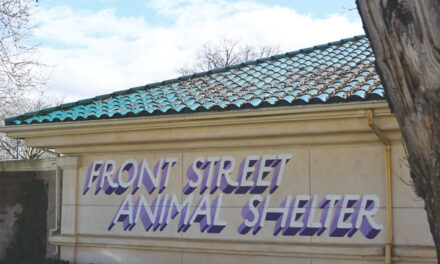It’s not complicated. High-volume spay/neuter is the most effective way to stop the influx of unwanted dogs and cats.
Lacking such a program, Front Street Animal Shelter has big problems.
In the five years since Phillip Zimmerman took over as Front Street manager, the city’s homeless animal population has exploded. Stray dogs and cats entering Front Street grew from 6,309 in 2022 to 8,457 in 2024.
The shelter takes in more strays than it can effectively and humanely house, a city audit says. “The No. 1 reason for crowding and intake is stray animals,” says Julian Metcalf, CEO with the audit firm GPP Analytics.

Overcrowded cages increase animal stress. Stress leads to illness and behavior issues, which lead to euthanasia. In 2022, Front Street killed 747 animals. In 2024, the number was 1,462.
Community spay/neuter is “a reasonable choice that could help reduce the intake,” Metcalf says. “We saw that as a practical solution.”
Lack of a community spay/neuter program is not the only problem. The audit found hundreds of unanswered calls for animal control, unfinalized policies and procedures, uncollected revenue-generating fees, and low employee morale and engagement.
“This audit knocked me back a little bit,” says City Council Member Roger Dickinson, who chairs the city’s Budget and Audit Committee. He says the audit is a “call to action,” with 10 findings and 31 recommendations.
“The best thing we can do is be as aggressive as possible about spay and neuter,” Dickinson says.
The shelter, built in 1992, is cramped and decrepit. Estimates for a new facility run $40 million to $60 million with a timeline of three to five years.
The audit suggests a temporary prefabricated building for shelter medicine and high-volume spay/neuter surgeries. This could “expand capacity, reduce wait times, and improve animal outcomes without unduly straining the budget,” the audit says.
Zimmerman makes excuses. He says there is no money, not enough staff.
Dickinson says, “How do we—working with others—do more with the resources we have?
What are the creative and nontraditional ways beyond what we are doing?”
That’s the problem. Zimmerman lacks creativity, initiative and the ability to think beyond what’s not working. “When I saw the audit, I freaked out too,” he tells the audit committee.
To address capacity problems and keep pets out of the shelter, Zimmerman embraces “community sheltering” and “managed intake.” He turns away healthy strays regardless of vaccination and spay/neuter status.
Past programs included “foster to adopt,” which led to hundreds of unaltered dogs and cats released to the public. Some, undoubtedly, reproduced.
The audit notes these strategies pose a legal risk to the city. State laws require cities to impound stray animals and manage rabies. These practices “do not address the root causes for animals coming to the shelter,” the audit says. The root cause being unaltered pets.
“This audit makes one thing clear. Front Street leadership has failed both the animals and the public,” says local animal advocate Julie Virga with the nonprofit Fix Our Shelters. “Under director Zimmerman, the shelter ignored state law, turned away animals in need, and abandoned core responsibilities like spay and neuter.”
Hilary Bagley Franzoia, a member of the city’s Animal Wellbeing Commission, says the audit “reflects colossal failures across the board by management.”
At a recent commission meeting, Bagley Franzoia cited Front Street’s policy to not pick up healthy stray animals, noting “90% of stray dogs are unaltered.”
Zimmerman says the policy, recently ended, was implemented before he joined Front Street.
“Mr. Zimmerman, you had five years to reverse the policy,” Bagley Franzoia says. “You get a free pass because you didn’t implement the policy, but you continued it?”
The audit says the shelter lacks sufficient animal control oversight and formal procedures. Front Street went without a chief animal control officer from June 2023 to this past January.
During that time, pending calls for animal control services increased to more than 2,000. Since hiring a chief animal control officer, “we have reduced that number of calls pending to under 500,” Zimmerman says.
Bagley Franzoia counters, “You were relieved and somehow joyful that it got down to 500. You seem OK with 500 pending calls.”
Zimmerman admits his failure to the Budget and Audit Committee. “When the audit came out, I was pleasantly shocked that our response times to priority one calls were as good as they were because I was expecting them to be much worse.”
The audit cites chronic staff vacancies and high turnover. “Understaffing has led to service inefficiencies and low employee engagement,” the audit says.
“Some staff report not knowing how they should act, what they should do and what the expectations are,” Metcalf says.
Low compliance with pet licensing—estimated 14% of city dogs and 7% of cats are licensed—led to funding gaps and costs shifted to taxpayers. Other revenue sources, such as adoption, impound and vaccination fees, are routinely waived.
Front Street has no messaging to increase compliance with licensing requirements. Other jurisdictions use social media, mailers, media campaigns, utility bills and municipal communications.
While Zimmerman says he’s implementing many of the audit’s recommendations, Virga asks, “Why did it take five years and a damning audit for him to finally pretend to care?
“Now he says he’ll finally act? It’s too little. It’s too late.”
To read the audit, visit cityofsacramento.gov/auditor/our-reports/audit-reports.
Cathryn Rakich can be reached at crakich@surewest.net. Follow us on Facebook and Instagram: @insidesacramento.















